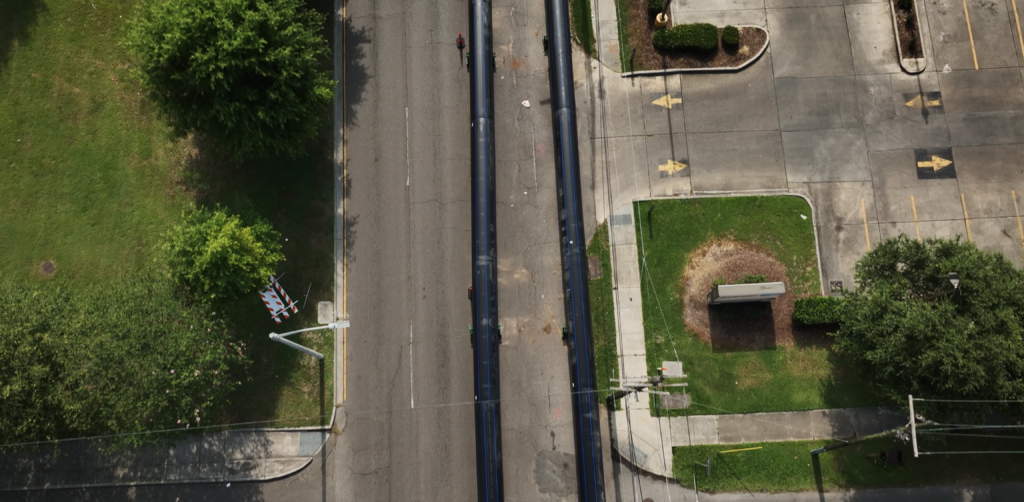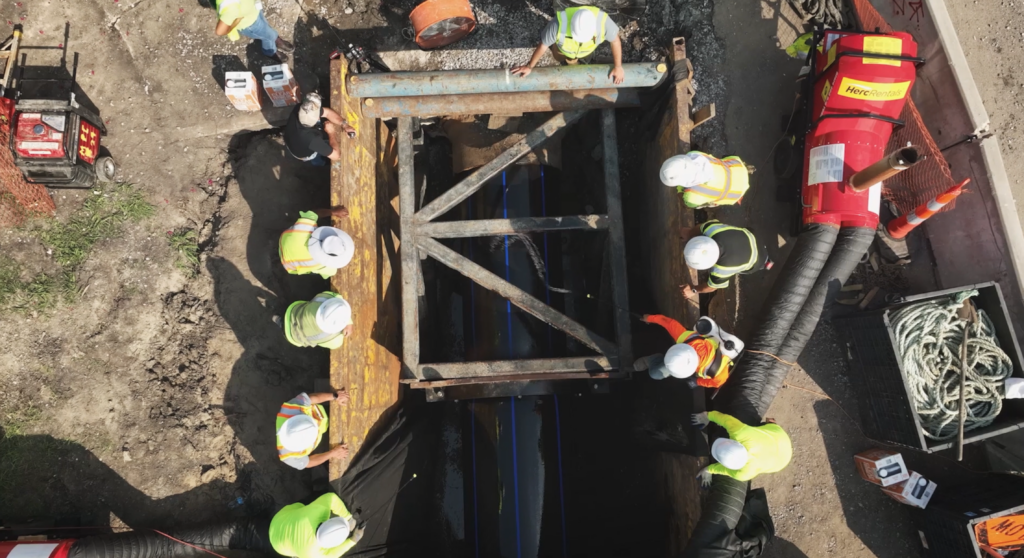This case study outlines using DIPS HDPE pipes to rehabilitate a transmission main in New Orleans, Louisiana.
Context
Hurricane Katrina wrecked New Orleans’ infrastructure and is on record as the costliest storm at ~$193 billion in damage, adjusted to 2023 (1). The storm coincided with many boil orders as untreated stormwater overwhelmed infrastructure and entered the water main (2). Since then, the city has not been the same.
Opportunities
The city’s aging infrastructure has led to numerous boil orders, unstable water pressure, and roadway/pavement damage from water main breaks. To rectify these issues, the Sewerage & Water Board of New Orleans launched an 11-project effort in 2023 to replace its 100- to 120-year-old water transmission mains with a modern piping system (3).
The South Claiborne Transmission Main Project, one of the 11 projects in New Orleans, aimed to stabilize water pressure in many parts of the city, improve water quality, and allow for long-term repairs for roadways and pavements (4, 5).
Solution
The city turned to Meyer Engineers, who helped design a solution incorporating two key elements to rehabilitate the transmission main.
First, their design called for the compressed fit installation method, which uses existing infrastructure as a framework for installing the new pipe. With this method, used extensively by Murphy Pipelines, pipes are pulled through the existing piping system. The pulling forces allow the pipe to stretch enough to fit through the previous pipe. Once the pipe has finished being pulled through the length of the section, the reduction in tension on the pipe allows it to stretch, compressing flush against the interior of the existing pipe. This technique, especially for the South Claiborne Transmission Main Project, helped reduce overall project costs, minimize traffic disruption, and simplify the installation and was a key aspect for securing project funding.
Second, the engineers chose high-density polyethylene (HDPE) for their solid wall piping system. HDPE pipes offer corrosion resistance, flexibility, durability, and lower seismic susceptibility than other piping materials such as concrete or steel. Moreover, it virtually eliminates leakage rate and features low biofilm formation potential, highlighting its capability to preserve water and water quality while transporting it (see Table 1, 6–10). HDPE pipes were also an ideal choice as their properties align well with the compressed fit installation method outlined in ASTM F3508.
AGRU manufactured over 5,600 ft of 30” and 48” (DIPS) SDR 17 HDPE pipes within the United States, specifically to support the compressed fit installation within the New Orleans’ legacy pipeline and help rehabilitate the transmission main. For AGRU, this meant expanding its manufacturing capabilities to support the Ductile Iron Pipe Sizes (DIPS) standard.
“The South Claiborne Transmission Main Project was the impetus behind our decision to expand our capabilities to support the DIPS standard,” said Natasha Arguijo, AGRULINE business unit manager. “We are pleased to have been able to adapt to supply our high-quality HDPE piping system for the city’s efforts to ensure infrastructure for a sustainable future.”
CMG Pipelines served as the subcontractor, supporting the project’s installation.
“This installation was a record-breaking Compression Fit project that challenged our team in every aspect,” said Carmelo Gutierrez, president of CMG Pipelines. “We are thrilled for the opportunity to tackle this project and are pleased with the feedback we have received from the owners. CMG Pipelines looks forward to collaborating with BLD, MPC, and AGRU on future projects.”
Outcome
The South Claiborne Transmission Main Project was completed by the Fall of 2023. Thanks to the compressed fit installation approach and HDPE pipes, project owners estimate an overall 25% savings compared with other methods (3).
“We see this project as the first of many to utilize our expanding line of pipes in the DIPS standard,” said Mrs. Arguijo. “We are excited for the future of AGRULINE in the United States as the go-to HDPE pipe and fitting system for owners seeking to build infrastructure for a sustainable future.”
Contact AGRU for support on projects that seek to rehabilitate transmission mains.
References
- “Costliest U.S. Tropical Cyclones,” NCEA. (2023). Accessed online at https://www.ncei.noaa.gov/access/billions/dcmi.pdf.
- “300,000 affected by New Orleans boil-water order,” (2010). Accessed online at https://www.sandiegouniontribune.com/sdut-300000-affected-by-new-orleans-boil-water-order-2010nov20-story.html.
- Dixon, “Claiborne Avenue water main project ensures fewer boil orders,” WGNO. (2023). Accessed online at https://wgno.com/news/local/claiborne-avenue-water-main-project-ensures-less-boil-orders/.
- “S. Claiborne Avenue Transmission Main Project,” (2023). Accessed online at https://www.swbno.org/Article/Details/s-claiborne-avenue-transmission-main-project.
- Pink. “S&WB to replace 3,500 feet of pipes under Claiborne Ave.—without closing the street. Here’s how,” NOLA. (2023). Accessed online at https://www.nola.com/news/swb-starts-massive-south-claiborne-avenue-pipe-project/article_8b833fcc-27d2-11ee-b53a-73b29b08ef0a.html.
- G. Rubeiz. “Case Studies on the Use of HDPE Pipe for Municipal and Industrial Projects in North America.” Pipeline Engineering and Construction: What’s on the Horizon? (2004).
- DeCou and P. Davies. “Evaluation of abrasion resistance of pipe and pipe lining materials.” California Department of Transportation. (2007).
- M. Rohsenow and J. P. Hartnett. Handbook of Thermal Conductance, translated by Y. T. Li. Beijing: Science Press. (1985).
- Nielsen et al. “Influence of pipe material and surfaces on sulfide related odor and corrosion in sewers.” Water Research. (2008). Accessed online at https://doi.org/10.1016/j.watres.2008.07.013.
- Rubulis and T. Juhna. “Evaluating the potential of biofilm control in water supply systems by removal of phosphorus from drinking water.” Water Science and Technology. (2007). Accessed online at https://doi.org/10.2166/wst.2007.261.
Overview
- Project: South Claiborne Transmission Main
- Location: New Orleans, Louisiana
- Products: 4,400’ of 48” DIPS SDR 17 and 1,150’ of 30” DIPS SDR 17
- Owner: Sewerage & Water Board of New Orleans
- Engineer: Meyer Engineers
- Contractor: BLD
- Installer: Murphy Pipelines (MPC)
- Subcontractor: CMG Pipelines
- Pipe Manufacturer: AGRU
Need Help Determining Which Product is Right For Your Application?
Interested in learning more about how one of our products can make a difference in your next project? Please reach out to us with your questions and one of our sales or technical staff will be happy to assist you.
We can help you determine your exact product or application-related needs. And because our products meet, and often exceed, industry standards you can rest assured knowing that you are getting the best solutions in the business.


